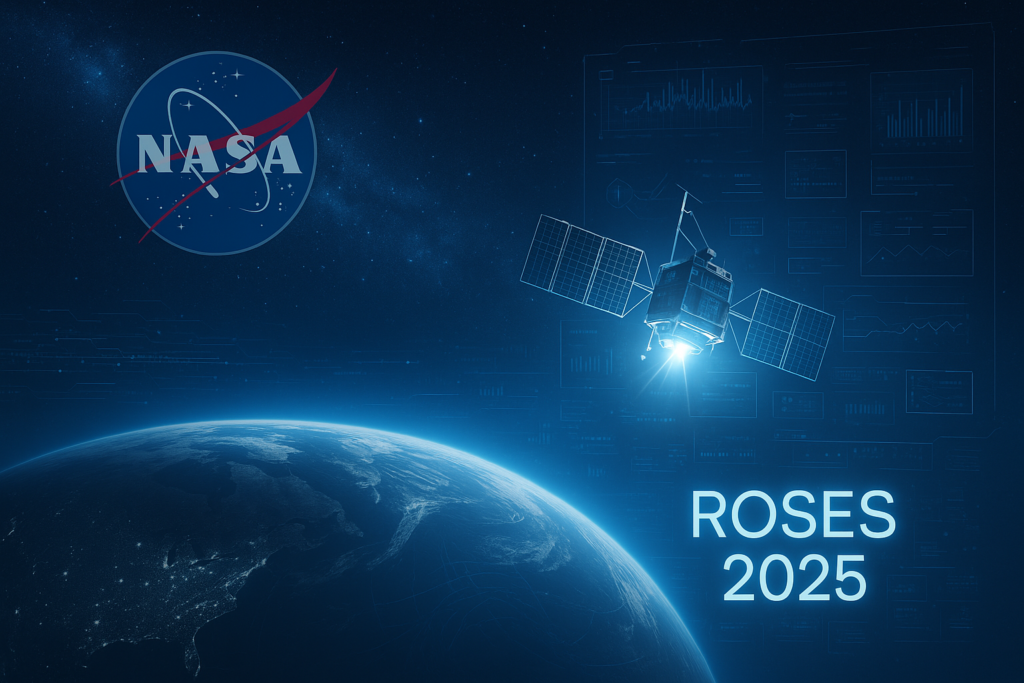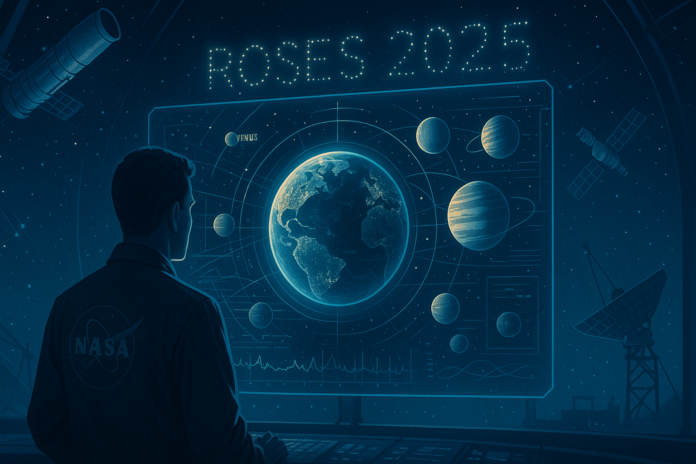
🌟 Introduction: What is NASA ROSES 2025?
NASA ROSES 2025, which stands for Research Opportunities in Space and Earth Sciences, is one of NASA’s most important and far-reaching annual research requests. It will be open in 2025.
The Science Mission Directorate (SMD) sends out the NASA ROSES 2025 call, which opens the door for thousands of scientists, engineers, institutions, and organizations to get money to do cutting-edge research in fields like Earth science, astrophysics, planetary science, heliophysics, and more.
If you want to get valuable funding and work with other people, you need to know about NASA ROSES 2025. This is true whether you are a first-time principal investigator or a seasoned researcher.
📚 Understanding the ROSES Program
NASA’s main annual research announcement is the ROSES program. It gives complete information about the funding options that the Science Mission Directorate offers.
Some of the most important things about ROSES-25 are:
Includes both theoretical and applied research
Helps with basic research, developing new technologies, analyzing data, modeling, and field work.
Available to schools, nonprofits, businesses, and international partners based in the U.S. (with some restrictions)
Promotes new scientific ideas and collaborations between different fields
NASA sends out the ROSES solicitation through the NSPIRES portal (NASA Solicitation and Proposal Integrated Review and Evaluation System). Researchers can use this portal to submit Notices of Intent (NOIs), proposals, and check for updates.
📆 ROSES 2025 Timeline and Key Dates
The official release date for NASA ROSES 2025 was July 10, 2025. Here are important timeline milestones every researcher should be aware of:
| Event | Date |
| ROSES-25 Official Release | July 10, 2025 |
| Step-1 Proposal Due (varies by element) | From August 15, 2025 |
| Full Step-2 Proposal Due | Between Sept – Dec 2025 |
| Proposal Review Notifications | Late 2025 to early 2026 |
| Project Start Date | Upon NASA approval (typically within 90–120 days) |
Tip: Each program element has a different deadline, so review the ROSES-25 Table of Contents carefully.
🔍 What’s New in NASA ROSES 2025?
- ROSES is updated frequently by NASA to take into account changing scientific priorities, regulatory requirements, and solicitation feedback. The following are the main ROSES 2025 updates:
1. DAPR, or Dual-Anonymous Peer Review
- Proposals must now adhere to Dual-Anonymous Peer Review (DAPR) guidelines for the majority of program elements. This implies:
- To avoid reviewer bias, proposals are de-identified.
- The identities of the proposer and reviewer are concealed.
- There are specific formatting rules in place to preserve anonymity.
2. Revised Formats for Proposals
- The following new formats are in accordance with the updated Grant and Cooperative Agreement Manual (GCAM):
- Template for a standard biographical sketch
- Template for Current and Pending Support
- Every proposal file needs to be unlocked and in PDF format.
3. A greater emphasis on inclusion and diversity
- NASA supports ideas that: Encourage diverse institutions and teams
- Incorporate Institutions Serving Minorities (MSIs)
- Talk about equity and workforce development.
4. Citizen Science & Open Data Emphasis
Certain ROSES-25 elements promote citizen science initiatives and require clear plans for open data sharing.
💼 Who Can Apply to ROSES-25?
Universities and colleges (based in the United States) are eligible to participate in NASA ROSES 2025.
For-profit and nonprofit organizations in the United States
Federal Labs and NASA Centers
International organizations (approved by NASA)
Principal Investigators (PIs) on their own
Each element has different eligibility requirements. Some only accept complete Step-2 proposals, while others require Step-1 proposals and Notice of Intent (NOI).
📝 How to Apply – Step-by-Step
Step 1: Register on NSPIRES
Visit nspires.nasaprs.com and create an account. Affiliations with your institution are required.
Step 2: Find the ROSES-25 Solicitation
Search for “NNH25ZDA001N” under open solicitations. Download the ROSES-2025 Table of Contents and identify relevant program elements.
Step 3: Review Deadlines
Each program element has unique NOI, Step-1, and Step-2 deadlines.
Step 4: Submit Required Documents
- Typical sections of proposals consist of:
- The Cover Page
- Technical/scientific narrative
- Justification of the Budget
- Plan for Data Management
- Biographical Illustrations
- Existing and Future Assistance
- Supporting Letters (if required)
Step 5: Anonymize for Dual-Anonymous Review
If your element uses DAPR, remove all identifying info from the narrative. Follow NASA’s template strictly.
🛰 Key Scientific Areas in ROSES-25
NASA ROSES 2025 includes dozens of program elements across these main divisions:
1. Earth Science
- Modeling the climate
- Sensing remotely
- Ocean and atmospheric science
- The interior and surface of the earth (ESI)
2. Planetary Science
- Analysis of Mars Data
- Lunar Exploration & Discovery
- Concepts of Planetary Instruments
- Research on Outer Planets
3. Astrophysics
- Origins in the Cosmos
- Research on Exoplanets
- Astrophysics with High Energy
- Archival Research on Space Telescopes
4. Heliophysics
- Modeling space weather
- Magnetosphere explorations
- Physics of the Sun
- Multidisciplinary heliophysics
5. Biological & Physical Sciences
- Basic Space Biology
- ISS physical science experiments
- Studies of radiation and gravity
💡 Tips to Write a Strong NASA Proposal
It takes more than just sound science to write a successful NASA ROSES 2025 proposal. Clarity, accuracy, and compliance are also important.
Here are some professional pointers:
✅ Comply with Mission Goals
In the program element description, make a clear connection between your proposal and NASA’s objectives.
✅ Be Data-Driven and Specific
Make use of the preliminary work’s findings, figures, and citations. Steer clear of generalizations.
Make a careful budget
Make sure your budget is reasonable, supported by evidence, and adheres to NASA’s program cost cap.
✅ Examine Wider Effects
When appropriate, incorporate elements related to workforce training, public engagement, or educational outreach.
✅ Observe formatting and page limits.
Numerous proposals are turned down due to minor infractions. Make use of NASA’s word counts, templates, and format.
🌐 Where to Learn More
- 🔗 ROSES 2025 Main Page: https://science.nasa.gov/researchers/solicitations/roses-2025
- 🔗 Proposal Submission Portal (NSPIRES): https://nspires.nasaprs.com
- 📄 FAQs & Training: science.nasa.gov/researchers/sara/faqs
- 📧 Help Desk: nspires-help@nasaprs.com
📣 Conclusion: Why ROSES-25 Matters
NASA ROSES 2025 is a compelling invitation to join humanity’s greatest exploration mission, not just a grant opportunity. ROSES-25 provides opportunities for significant research, interdisciplinary cooperation, and societal impact, regardless of whether you study the stars outside our galaxy or the oceans on Earth.
Use it carefully. Observe the rules. And have courage when expressing your thoughts.
📌 TL;DR
- On July 10, NASA released ROSES 2025.
- Topic-specific proposal deadlines range from August to December 2025.
- Significant changes include new templates and a dual-anonymous review.
- Use NSPIRES to apply.
- Possibilities in the fields of life, planetary, space, and earth sciences
- Strong emphasis on equity, open data, and innovation





[…] 🚀 NASA ROSES 2025: An All-Inclusive Guide to Space and Earth Science Research Opportunities […]
[…] 🚀 NASA ROSES 2025: An All-Inclusive Guide to Space and Earth Science Research Opportunities […]
[…] 🚀 NASA ROSES 2025: An All-Inclusive Guide to Space and Earth Science Research Opportunities […]